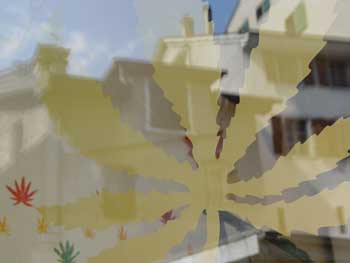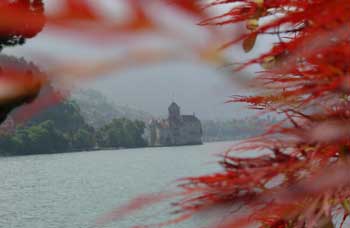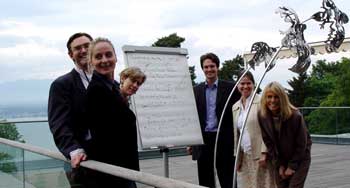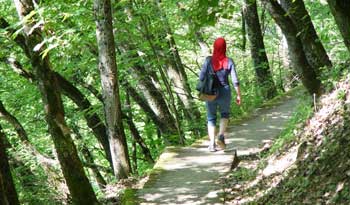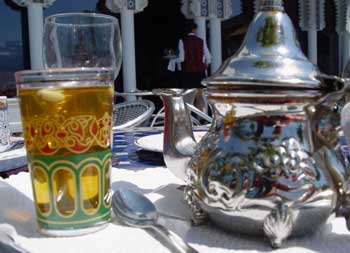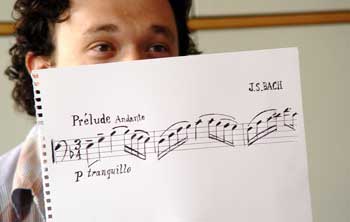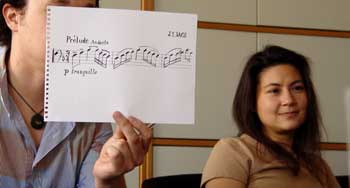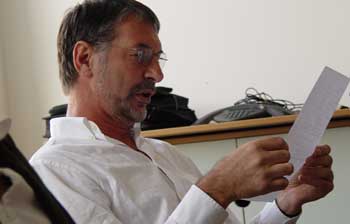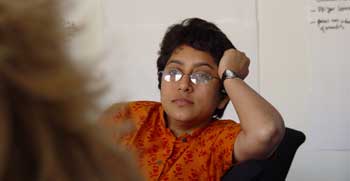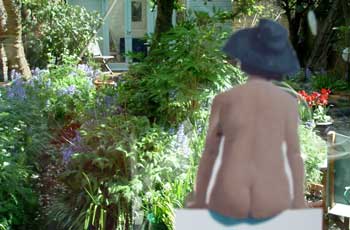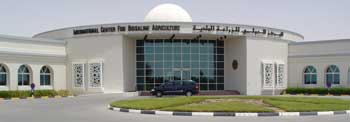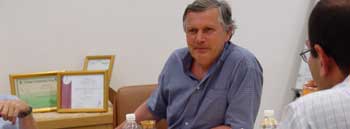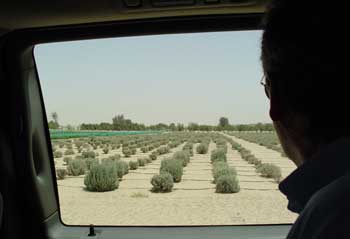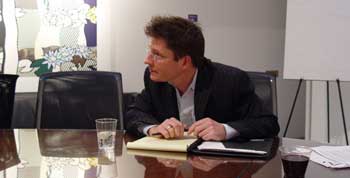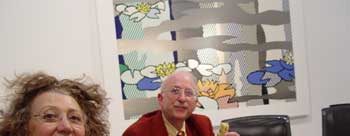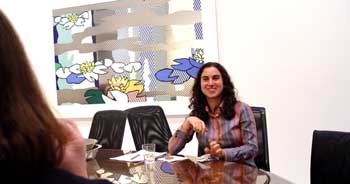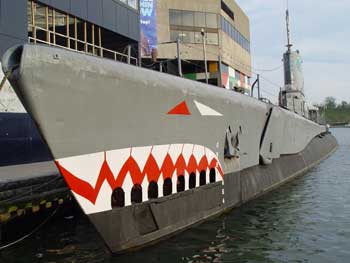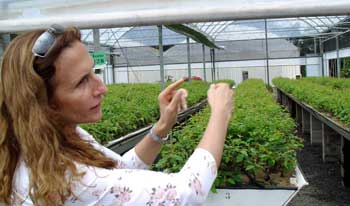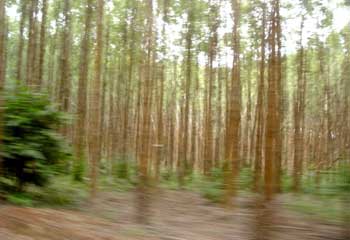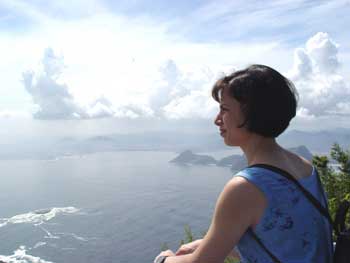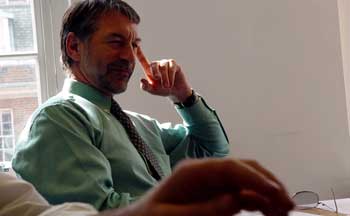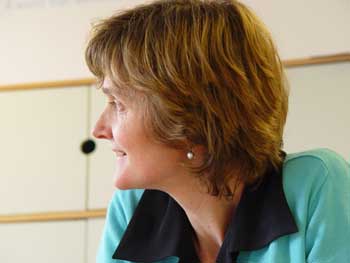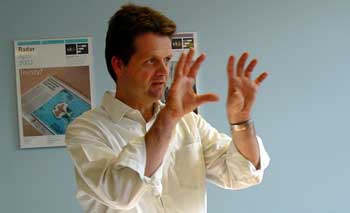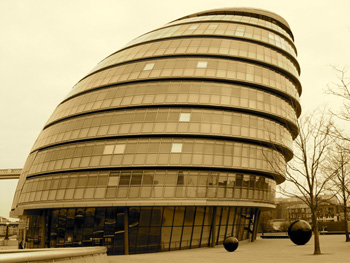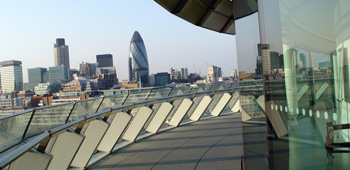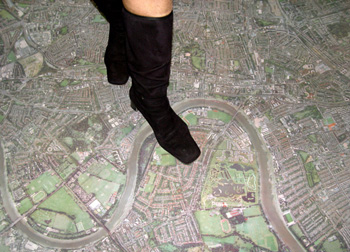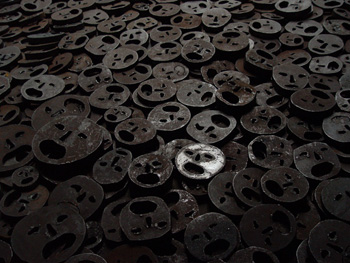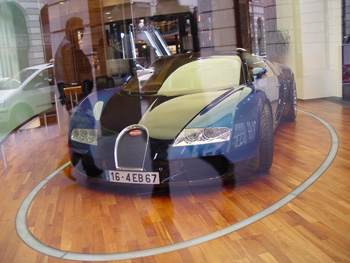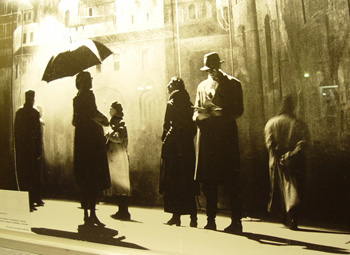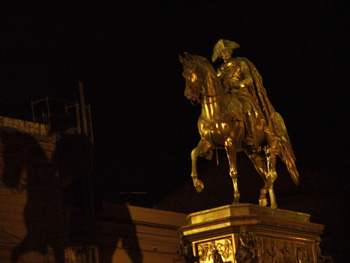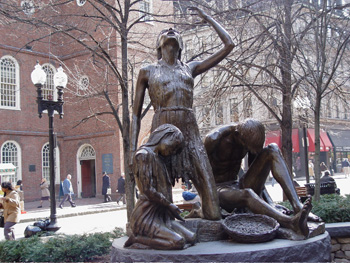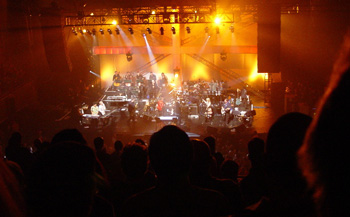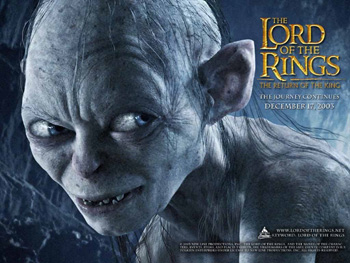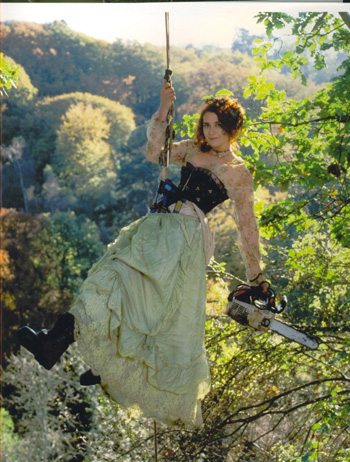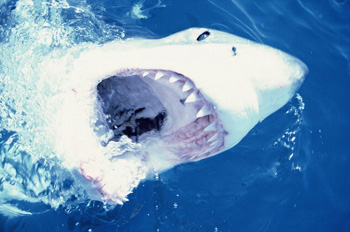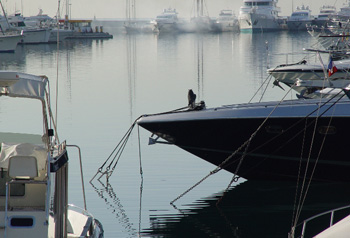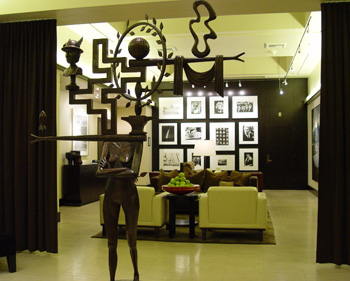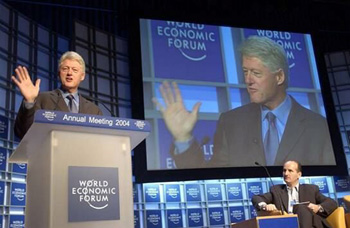Wednesday, June 30, 2004
SPOUTING IN BRUSSELS
Doesn’t often happen, but have more or less lost my voice. Partly a result of something I picked up on the flights to or from New York, partly a function of speaking for a couple of hours at a European Institute for Industrial Leadership (EIIL) conference in Brussels on Monday evening, then for another three hours the following morning. But, though I missed the funeral in Edinburgh of a family friend (oddly, his brother organised the EIIL event), it was worth it. The focus of the two sessions in Brussels was on sustainability and engineering – and engineers are prime targets for conversion, alongside chief financial officers (CFOs), brand managers, line managers, entrepreneurs and venture capitalists.
Sunday, June 27, 2004
BETWEEN THE LINES
Struck me this morning, in re-reading previous blogs, how much one leaves out.
So, for example, there have been ups. Hania arrived back from Los Angeles on Thursday, where she had been invited to see the screening of a short film based on her first script. This was co-authored with a close friend, who is studying film-making there. They then drove north along the coast. She brought me back an interesting CD by a group called ‘Iron & Wine’.
And there have been severe downs. The last couple of months saw disaster for our best friends, with one of their sons breaking his back in China and having to be airlifted to Hong Kong for surgery. We heard the news before his parents, who were away for the weekend. He is now back in the country, has had further surgery and the saga continues, though the latest news sounds a bit better.
Both stories, though, illustrate just how dependent many of us have become on air travel. Indeed, while I was in New York, Malcolm McIntosh told me that the ‘CSR Blokes’ network recently circulated an e-mail suggesting members look at this site and calculate how many Air Miles I had accumulated. However many, the poetic justice element is always there: the air traffic streaming in towards Heathrow and, today, various helicopters buzzing around, presumably for Wimbledon.
Saturday, June 26, 2004
AND THE GLOBAL COMPACT IS 5
The UN Global Compact (www.unglobalcompact.org), catalysed by UN Secretary-General Kofi Annan in 1999, is 5. The idea has been to give a “human face to global markets”. The ‘Leaders Summit’ at the UN HQ in New York was designed to attract CEOs of companies that have signed the Global Compact. It triggered a counter-summit by NGOs, on 23 June, which seems to have concluded that the Compact is a giant corporate monster that has taken over the UN. It’s great that the civil society world keeps the UN under pressure on this, but the view from inside was rather different. In fact, so many participants wanted to attend the formal Global Compact session on 24 June that the UN had to remove the wall between the conference area and the delegates’ dining area.
The recurrent theme: the need to move from talk to action. The most convincing inputs came from the likes of President Lula of Brazil (focusing on poverty) and Lord John Browne of BP (focusing on climate change), both of whom are trying to drive change in the real world. Oded Grajew of Instituto Ethos (www.ethos.org), one of the organisations we work with in Brazil, built on Lula’s line of argument by saying that we ought to pay at least as much attention to the 30,000 children who die every day as we do to the victims of terrorism – or, I reflected, the victims of terrorism of our own nationality.
One of the announcements that attracted most attention was that Brazil’s leading samba school is adopting the Global Compact principles as its theme for its contributions to next year’s Carnival in Rio. Great. The sexier we can make all this, the better, but I was more interested in the work that the Global Compact team is now doing to convert the world’s stock exchanges. And they seem to be making a measure of progress.
Kofi Annan also announced the launch of a tenth Global Compact principle, on anti-corruption. We were told that corruption costs the global economy something like a trillion dollars a year, “a cancer”, “a hidden tax”. A great tribute to the work of people like Transparency International (www.transparency.org).
Much of the day involved roundtable discussions. In one, designed to envision what might have happened by 2015, I got our table to work up an idea based on Brazil, South Africa, India and China launching a 21st century, global version of the 1940s Marshall Plan for the rebuilding of Europe and Japan. The result: a shamed rich world queues up to join. The EU, the US and also – this bit wasn’t my idea – the Arab-Israeli Economic Union. One can but dream! Given that the table started out thinking about whether sending a diverse team of astronauts to Mars would unite the world, I thought this was progress of a sort.
Met masses of people, some of whom I knew, others – like Mary Robinson, now of the Ethical Globalization Initiative (www.eginitiative.org) – I didn’t. At one point, Jane Nelson and I strolled along one of the corridors to look at a sculpture given to the UN by Nigeria. Encouraging, perhaps, that something of such beauty can come out of such a radically corrupt country. Later, on my way out, I came across a glass case containing a gift from Mauritius, this a gilded dodo. I confess that I wondered whether changing global conditions might not consign the Global Compact – and perhaps even the UN itself, like the League of Nations before it – to such museum cases during the coming century. If either is to survive, the level of change likely to be required will be be profound.
Four themes where I think action is needed are these:
(1) Legitimacy: Voluntary initiatives – and particularly the Global Compact – are likely to come under growing pressure from civil society organizations. The appetite to go ‘wider’ (e.g. recruiting more corporate members to such initiatives) instead of going ‘deeper’ (e.g. encouraging members to expose their boards to some form of the Challenge we proposed on page 37 of SustainAbility’s new report, Gearing Up: see www.sustainability.com) raises real concerns about potential longer term risk to the UN’s reputation. At least that was the point I was pushing in the corridors.
(2) Scale: This was the theme of the main morning session at the Global Compact event. How do we take good experiments and pilot projects and grow them to the scale that will be needed in a world of 7-9 billion people? Unfortunately, the evidence suggests that most companies’ CSR departments currently have little idea about market creation, business models or other areas that are becoming increasingly relevant.
(3) Governments: To ensure scalability, governments will need to take a much more active role, e.g. through fiscal and financial instruments, shaping markets with rewards and disincentives. A point we address in Gearing Up – and Francis Fukuyama tackles in his latest book, on state building.
(4) Corporate lobbying: And if governments – which currently lean over backwards to protect the interests of business – are to become more courageous, more attention will need to be paid to the extent to which corporate lobbying by companies (including Global Compact signatories) aligns, or doesn’t, with their stated commitment to the goals of such voluntary initiatives. Also covered in Gearing Up.
Several speakers at the NY event – among them Kofi Annan and Harvard’s Professor John Ruggie, one of the Compact’s original architects – argued that the Compact was a sign that the UN can re-invent itself. An experiment that could have wider implications for the entire institution. Perhaps, but if it is to play that role my sense is that the Compact will need to develop some teeth. The announcement of new ‘integrity measures’, to ensure that fewer companies can use their Compact membership as an alibi for inaction on other fronts, is a welcome step in the right direction.
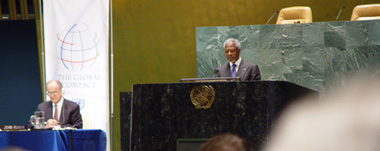
Kofi Annan in the General Assembly Hall, John Ruggie on left (©JE)
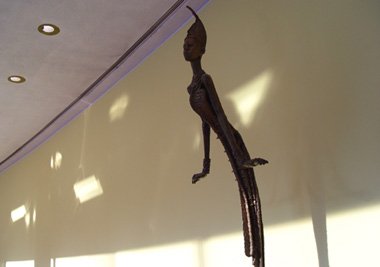
A Nigerian gift to UN (©JE)
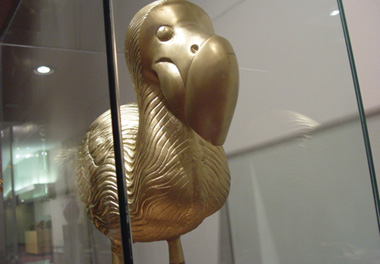
A gift from Mauritius (©JE)
Wednesday, June 23, 2004
NOW I’M 55
Wonderful flurry of birthday cards this morning as I gird my loins for New York. En route to UN Global Compact’s fifth anniversary event. 2004 is my 55th year and, it hits me, marks my 30th year of professional work in this field, whatever that may be. It’s amazing how much has changed since 1974 – and how much will need to change over the next couple of decades.
Saturday, June 19, 2004
PRUNES THE MULBERRY
Today’s papers full of the news of another beheading in Iraq and the agreement yesterday that promises to move the EU towards a new constitution. Having been a member of the European Commission’s Consultative Forum on Sustainable Development for seven years, I take more than a passing interest in the evolution of the Union. Among other changes in prospect – though member states will need to ratify, with 6 (including the UK) now pledged to hold referenda – are a full-time President (an ex-PM), double majority voting (which will mean that new policies will be approved if voted for by at least 15 of the 25 member states, and by more than 65% of the EU population) and, by 2014, a pruning of the 30-member Commission to just 18 members.
Pruning was also on our minds in Barnes today. Less ‘Dances With Wolves’, more ‘Prunes The Mulberry’ this afternoon as Gaia, Elaine and I cut back the mulberry, apple, crab apple and bay trees that were threatening to cut our small London garden off from the fitful sun. In the background, aircraft rumbling into Heathrow (see photos: at least Concorde has gone) and Hank Williams. Gaia had brought back a double CD and we were amazed how many well-known songs he wrote. Among them: Cold, Cold Heart, covered by Norah Jones (among my Top 16), Hey, Good Lookin’, Your Cheatin’ Heart and Jambalaya.
Also listening to a CD by Fritz Reiner and the Chicago Symphony, sent to me via Amazon a few days back by John Manoochehri in Nepal. Reading this website, he had noted my encounter with Bocklin’s painting The Isle of the Dead in Berlin earlier in the year – and sent the CD because it contains a rendering of Sergei Rachmaninoff’s Op. 29, The Isle of the Dead. Thanks, John.
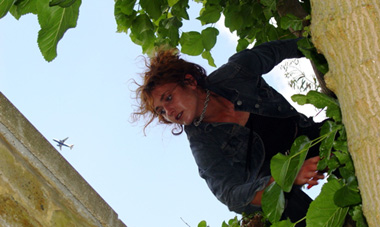
Gaia 1 (©JE)
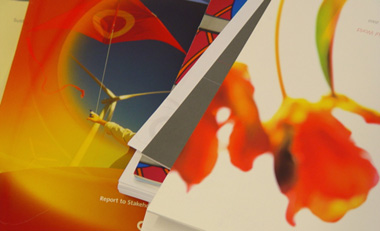
Gaia 2 (©JE)
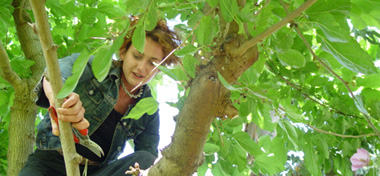
Gaia 3 (©JE)
Friday, June 18, 2004
GLOBAL REPORTERS TASTING SESSION
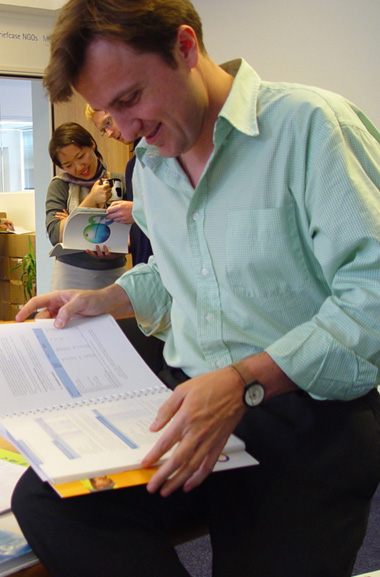
Cornis samples a report (©JE)

Nice colours … (©JE)
In the past, I often used to describe sessions where we sampled the latest corporate environmental, social or sustainability reports as akin to wine tastings. Today, Nick Robinson hosted the judges panel for our forthcoming Global Reporters 04 report benchmark survey at SustainAbility. The judges included Jon Hanks, who I first met years back in South Africa and who has done a great deal of work with the United Nations Environment Programme (UNEP), Cornis van der Lugt of UNEP, Nick Robins of Henderson Global Investors (who co-wrote our second reporting on reporting with me, Company Environmental Reporting, way back in 1994) and Stanilas Dupre of Paris-based Utopies. The team included Judy Kuszewski, who used to run the Global Reporting Initiative when it was still at CERES, and a number of interns.
Some photos of the session are posted above and below. Among other things, they include a picture of a coffee cup – a tongue-in-cheek reference to the story we used to tell ten years ago that some of our reporting ideas, a number of which swept around the world, were created over a cup of tea. German academics were incensed that we hadn’t taken many years and hundreds of thousands of deutschmarks to do the work. Well, we have spent many hundreds of thousands of pounds over the past decade in developing our report evaluation methodology, but the cups of tea and coffee still play a vital role.
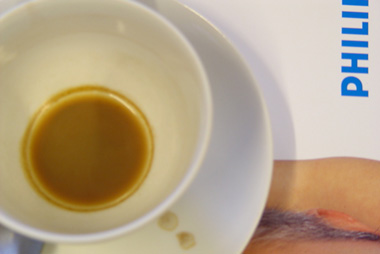
Coffee-fuelled … (©JE)
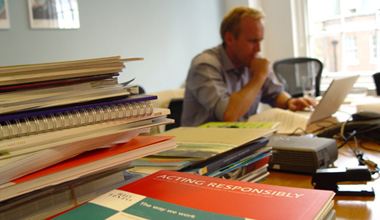
Jon reflects among hundreds of reports … (©JE)

Nick, Daniel, Cornis, Stanislas (©JE)
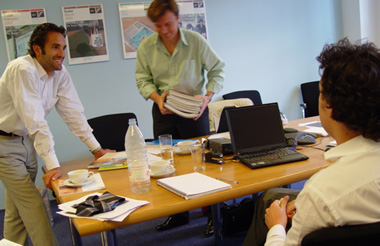
Stanislas, Cornis and Nick (©JE)
Wednesday, June 16, 2004
ECGD AND SD
Today’s Financial Times argues that UK exporters and their customers are suffering because of ongoing uncertainties around the future of the Export Credits Guarantee Department (ECGD), where for several years I have been a member of the Advisory Council. It certainly is hugely frustrating. But the FT also notes that the House of Commons inquiry which has spotlighted these concerns also calls for a “clearer statement of the ECGD’s policy in support of sustainable development.” Rather than being a ringing endorsement of the inclusion of SD in ECGD’s policies, however, this reflects exporter concerns about the effects of requiring the ECGD to take non-financial objectives – including environmental impacts – into account.
LIVINGSTONE, I PRESUMED
Ken Livingstone is back as Mayor of London. I filed a postal ballot for him before leaving for the US – the first time I have voted Labour. Not that I like Labour at the moment, but Livingstone has shown remarkable courage for a politician, particularly with his congestion charge system for central London. Even though his majority this time is slimmer than in 2000, his re-election is a significant victory in the ongoing political battles around sustainable mobility.
AROUND THE WORLD IN EIGHT DAYS
Having left for US on 7 June, I got back last night from Tokyo, having flown round the world in eight days. Series of visits with NGOs and companies. Both mornings I was in Japan, I did breakfast interviews with newspapers, the Asahi Shimbun and Nikkei (Nihon Keizai Shimbun). They’re interested because there has been a huge growth in activity in Japan in the area of corporate social responsibility (CSR). Big controversy in the papers currently is the cover-up at Mitsubishi Fuso, which has admitted that it has concealed defects in its trucks for eight years. The company recalled 220,000 trucks in March and another 180,000 in May. Now it says it will recall a further 450,000.
Monday, June 14, 2004
GRI JAPAN
Arrived at Narita airport from JFK and, after some hiccups, made my way to Le Meridien Pacific Hotel in Shinigawa. I had a delightful dinner with Goto-san, who runs the Japanese end of the Global Reporting Initiative (GRI) and a couple of his colleagues, Sugimoto Hiroko (GRI: wwww.gri-fj.org) and Ayako Sonoda Ecotainment Group: www.cre-en.co.jp).
Ecotainment have just done an interesting short sustainability report, which features a lot of people smiling – something you wouldn’t have seen in Japanese reporting a few years back. Indeed, one of the things we called for in one of our reports on reporting was more smiles – not as ‘aren’t-we-friendly’ PR, but to end the era during which Japanese executives in almost all environmental and sustainability reports looked as if they were having teeth pulled.
One thing that struck me about Japan today, compared with the last time I was there, seven or eight years ago, is how the cell phone craze has spread – and the way that people use them to take photos these days.
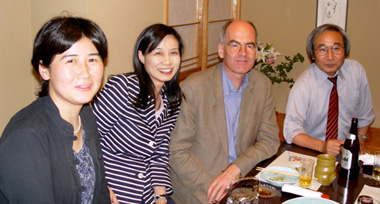
Sugimoto Hiroko, Ayako Sonoda and Goto-san
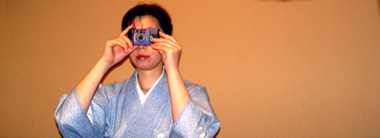
The photographer

And now let’s try a mobile
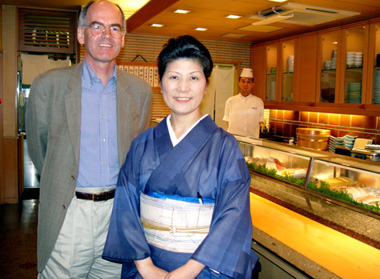
Thank you and goodnight
Friday, June 11, 2004
REAGAN SNAKES HOME
Walked up Park Avenue to Borders, the bookshop, to browse. Weird and wonderful selection of magazines, though I return with a somewhat pedestrian foursome: The Economist, which praises Reagan for defeating Communism; MITs Technology; Scientific American, which is frothing with nanotech and stem cells; and Strategy & Business, which has an article (not yet read) on the art of scaling up business ventures, one of the themes I developed in my summing up earlier today.
On the way back, around 20.30, the western sky, glimpsed down skyscraper corridors, was a rather delightful gold-flecked tangerine. Glimpsed on several wide-screen TVs in a store window: without sound, I assume this is the snaking cavalcade of vehicles returning Ronald Reagans body for burial.
Passed the Waldorf-Astoria, only a block from The Barclay, recalling when Elaine and I stayed there during the extraordinary 2002 World Economic Forum event. At the time, the area was surrounded by mounted policemen and rumbling white-painted trucks filled with sand, designed to prevent suicide bombers.
The trauma of 9/11 is still powerfully shaping events here. Several people at the conference yesterday were wondering what would happen if something similar happened on US soil ahead of the impending Presidential elections: the consensus was that it would guarantee a third term for the current regime.
MARS ORBITS VENUS
On Wednesday morning, I took part in SustainAbilitys roundtable with companies (including American Honda, Dow Chemical, IBM, Procter & Gamble and Shell US), hosted by ChevronTexaco in their DC offices, on the question whether the Atlantic is getting bigger as the US and EU takes on issues like security, human rights and CSR diverge. A very interesting discussion, with a sense that the divide is growing, and a clear appetite among the companies for further sessions.
Those present were at pains to distinguish between reactions to President Bush, the US Government and America generally. One of my points, though, was that while the reactions to date have mainly focused on the President, the collateral damage of what he has been doing is progressively undermining Americas position in the world particularly when we now have lawyers saying that Bush would be within his rights to authorise torture.
Late on Wednesday, I flew from Reagan National Airport (a couple of hours before the late Presidents body arrived in DC) to New York, and have since been at The (Intercontinental) Barclay. Did the summing up keynote today for the Conference Boards 2-day event on Business and Sustainability, which was held here. Tongue in cheek, I equated the Business of the conferences title with Mars and Sustainability with Venus. Started with the photo of Venus against the Sun earlier in the week and went on from there.
Very positive reactions. This website, though, bit back to a degree when Katherine Reed (3Ms Staff Vice President, Environmental Health and safety Operations), as part of her introduction, not only mentioned Douglas Adams and the Babelfish but also said that she had seen that my early travels had exposed me to world music and then, of all the tracks discussed on the site, noted that I had been influenced (see Influences) by the Davy Crockett song I had heard in 1950s Northern Ireland!
True, but only in that later I realised that the song was akin to a perpetrator-eyes-view of one of the greatest tragedies of recent centuries: the extinction of North American Indian culture and peoples.
Last night, finally, while preparing my slides for today, I had an urgent e-mail from the London office, asking what had happened to the riposte I was meant to have done to an article on CSR and philanthropy by Michael Porter and Mark Kramer. This was for European Business Forum. The two pieces to run in parallel. When I get back from Tokyo, where I fly tomorrow, I must try to get permission to post both pieces here and also update the articles section of the site.
Thursday, June 10, 2004
SUSHI AND WWII IN DC
Having arrived in Washington, D.C. yesterday afternoon, I was delighted to see the statue of Gandhi striding purposefully along outside my hotel bedroom. ‘My life is my message.’ Awoke at around 04.00 with head full of ideas for conference presentations and possible book, then just after 06.00 – as I typed away on my ThinkPad – the sun popped above the horizon, and there was Venus in transit across the reddened orb. Had known it was due to happen, but it was complete serendipity that I actually got to see it.
According to NASA, transits of Venus across the disk of the Sun are among the rarest of planetary alignments. Only six have occurred since the invention of the telescope (1631, 1639, 1761, 1769, 1874, 1882). The next two will occur on 2004 June 08 and 2012 June 06. See http://sunearth.gsfc.nasa.gov/eclipse/transit/venus0412.html

Venus mini-eclipse of Sun (©JE)
Spent the day with the US team: Jeff, Katie, Mark, Philippa and Rebecca. Very energetic and fruitful session. Then, after lunch, four of us took time out to visit the new WWII monument that was dedicated on 29 May. While the site, between the Lincoln and Washington memorials, is very striking, and the fountains add verve to the scene, I found the design of the WWII memorial leaden, uninspired. A bit like part of the Atlantic Wall in places.
Indeed, the most interesting aspect of the thing was the scatter of personal tributes stacked here and there, with photos of the dead or of veterans, and stories of what they had had to endure. One commentator is quoted in today’s USA Today as saying that this generation didn’t want to talk about their exploits, so their families are now doing it for them.
But there has been something of a squabble, with the National Park Service saying the memorial wasn’t designed to include all these other tributes, which are collected at the end of every day and will be stored in a Maryland warehouse. A shame: the thing should have been designed from the outset to attract, spotlight and build on popular memories of the 16 million Americans who served in WWII – and the 400,000 who died. There are some 4000 stars, each representing 100 American dead.
The monument dates WWII 1941-1945, which while accepting the scale of the US contribution slightly overlooks the fact that other parts of the world had been at it since 1939. And the top name on the credits is President George W. Bush, which we found slightly peculiar. His father may have fought in the war, but George Bush II’s personal war record could scarcely be described as glorious. Overall, a mixed experience, but there’s no doubt that the US contribution in the 1940s did save the world as we know it.

Stars (©JE)

Lincoln memorial (©JE)
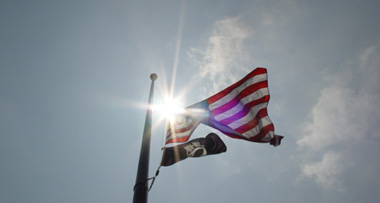
Stars and Stripes (and Missing in Action flag) at half-mast, in honour of Ronald Reagan (©JE)
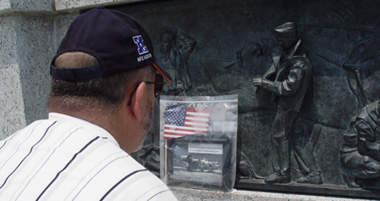
Poring over memorabilia (©JE)

Washington Monument through the ‘teeth’ of WWII memorial (©JE)
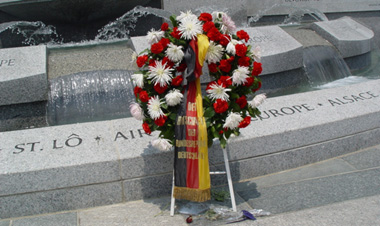
Germany’s wreath in tribute, near Atlantic War memorial (©JE)
In the evening, we went out and had a sushi dinner. Though the waitresses were Asian, some of the music seemed to have a distinctly American military feel to it, I thought. But it struck me that the US taste for sushi must have had at least soimething to do with the US occupation of Japan post-WWII.
And Gandhi was still striding along when I got back to the hotel. His extraordinary wrong-footing of the British Empire, by choosing to attack it via the salt tax and his walk to the sea to boil seawater to produce salt, was a contributory factor to my brainstorm at 04.00 this morning.
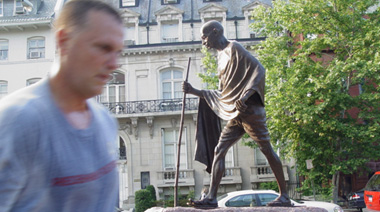
Gandhi on the march (©JE)
Sunday, June 06, 2004
METAL FATIGUE
Weird. While in Wiltshire, I finished Nevil Shute’s book No Highway, which is all about metal fatigue. Something I had read in my teens and wanted to revisit. Then working away this afternoon, my chair collapsed under me. Metal fatigue. Made by Verco, it has done excellent service. Indeed, I think I’ve written 16 books seated in it. And Julia (Hailes) worked from it for a couple of years, too. Now, some 24 years on, it has decided it has had enough. A portent, perhaps? Maybe next time I should get one with an ejection module?
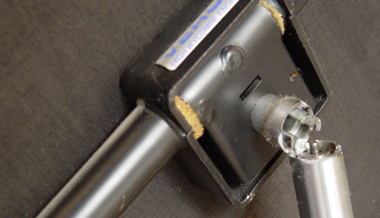
The chair it was that died (©JE)
THE GREATEST GENERATION
Working on our report for the UN late last night, I heard that Ronald Reagan had died. Odd, since I had found myself wondering what had happened to him 3-4 days back. The further we get away from him, from Margaret Thatcher and from the collateral damage they caused, the better they look. Visted Reagan’s website (www.reaganfoundation.org) this morning and was struck by just how fast we are moving away from the world of the ‘Greatest Generation’, a sense that has been reinforced by reading the McCulloch biography of President Truman – and by today’s ceremenies marking the 60th anniversay of the D-Day landings.
One quote of Reagan’s which has always struck me was this one, from 1982:
“…I know it’s hard when you’re up to your armpits in alligators to remember you came here to drain the swamp.”
Reading the accounts of what it was like to be pinned down on Omaha Beach, this resonated, but it must also resonate with those pinned down in Iraq. Longer term, though, I’m pretty sure that Bush II will not look better with the passage of time. Indeed, I suspect that much of what the Bush nexus got up to with the Saudis and others will begin to look like the swamp that had to be drained for the good of all.
Saturday, June 05, 2004
WHITE SHEET DOWN
A psychotic peacock, a neolithic hill fort and a herd of wapiti: highlights of the last couple of days, which we spent with Gaia near Maiden Bradley, Wiltshire. The peacock had appeared out of nowhere to terrorise The Spread Eagle inn, where we wandered the Stourhead grounds literally across the road shortly after arriving on Thursday evening. That night we were periodically woken up by the peacock, which seemed quite close by. When we went out in the morning, it turned out that the wretched thing was roosting on the inn’s roof, not much more than a dozen feet from our bedroom window. And the racket was much worse the next night.
One of the women in the inn said that no previous peacock has behaved this way, making a ferocious racket from the early hours (Elaine says 03.30 onwards). But the woman also said that the bird has taken to attacking the paintwork of her car, presumably seeing its own reflection as a potential rival.

Floral lava plunges into Stourhead lake (©JE)
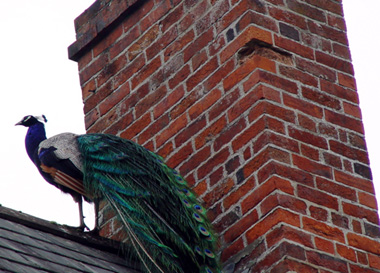
Psychotic peacock, Spread Eagle (©JE)
Today, we went back to Gaia’s cottage – the lane to which is awash with pheasants, partridge, the scattiest hares and, last night, what I think was a muntjac deer – and walked up onto nearby White Sheet Down. Through flocks of several different types of sheep, one of which, though otherwise white, looked as if all its members had put their heads into a bag of soot – and thence along the ridge to the spectacular neolithic causeway camp.
Overhead, a little tug plane puttered as it hauled gliders up into the sky, while unseen larks poured a cascade of song upon our heads. Something I don’t think I’ve ever seen before was the white footprints and trails left by the rabbits emerging from their burrows, dug deep into the underlying chalk. As we walked, the hill sides were aflutter with Chalk Hill Blues. On our way back to London, Gaia took us to Bush Farm (www.bisonfarm.co.uk), near West Knoyle, where they have a herd of bison – and another of elk (wapiti).
They had a strangely pin-head look viewed face-on, but then their heads looked extruded when viewed sideways on. No doubt we looked strange to them, too. Looked up the word wapiti when I got home: Shawnee word for ‘white deer’ (wap being white), to distinguish them from moose. Bought a pair of red deer antlers for Gaia: they suited her.
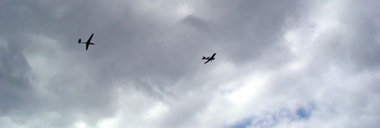
Glider and tug over White Sheet Down (©JE)
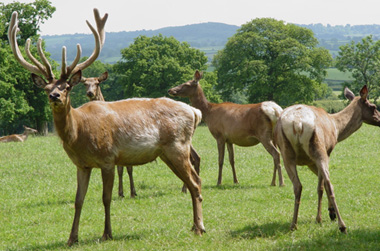
Wapiti at the bison farm, West Knoyle (©JE)
Wednesday, June 02, 2004
CROWS AND ANGEL
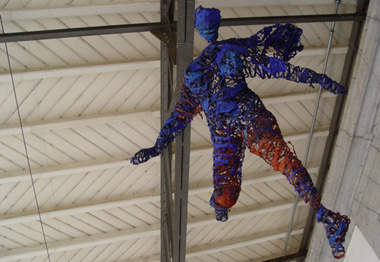
Winged sculpture in Montreux station (©JE)
The crows that had provided such a raucous wake-up service at the hotel seem to spend their days picking over the platforms and rails of the nearby station. Their black bodies, beaks and eyes almost disappear against the oiled sleepers and rain-darkened rails. Imagine myself lying on a battlefield, my armour plate already rusting in the drizzle, their beady eyes on the joints and cracks. I love to watch them them doing aerobatics and playing ‘chicken’ with one another, but have no illusions about their omnivorous tendencies.
Nor should they have about ours: in the Truman book I was reading a section in which journalists who made the wrong call on the 1948 US presidential election offered to “eat crow” while Truman, who had semi-miraculously won, “ate turkey”. Truman’s response spoke volumes about the man, but if push comes to shove most of us would eat crow as readily as they would eat us. Even as a 30-year non-carnivorous omnivore I’m sure even I would succumb.
And while on the subject of winged entities, most people seem to walk beneath it without an upward glance, but we rather liked the spectral angel hanging from the roof of the station as we waited for the train to Geneva airport.
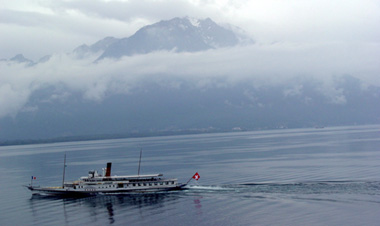
Rhone (vessel) heading counter-current to Rhone (river) (©JE)


